 7 Ways to Improve Estrogen Metabolism
7 Ways to Improve Estrogen Metabolism
Estrogen metabolism plays an enormously important role in women’s and even men’s health. Estrogen is the primary female sex hormone, and it is also present in men at low levels. In this article, you will discover the role of gut health in estrogen metabolism and 7 ways to improve your hormone balance.
Your gut flora is a large and complex community of microorganisms in your digestive tract. It has many critical functions in the body and has a significant impact on your overall health. One of the functions of gut flora is to regulate estrogen levels.
The estrobolome is the collection of microbes in the gut that are responsible for metabolizing estrogens into estrogen metabolites. These microbes produce beta-glucuronidase, an enzyme that deconjugates estrogens into their active forms. This unbound, active estrogen can then bind to estrogen receptors throughout the body to carry out many physiological processes.

The Role of the Estrobolome in Estrogen Metabolism
When gut flora is imbalanced, beta-glucuronidase activity is altered. This can be a major factor in a woman’s exposure to circulating estrogens. There are three main forms of estrogen: estradiol, estrone, and estriol. Estrogen circulates through the body to different receptor sites.
Decreased beta-glucuronidase activity and lower estrogen levels can lead to chronic diseases such as obesity, cardiovascular disease, PCOS, and osteoporosis. Increased beta-glucuronidase production leads to higher levels of circulating estrogens. This is linked to endometriosis, certain cancers, and many other symptoms related to estrogen dominance.
A healthy, balanced gut flora is important for proper beta-glucuronidase activity. It is critical to address any imbalances or dysbiosis in your gut flora to prevent or improve imbalances in your hormone levels.
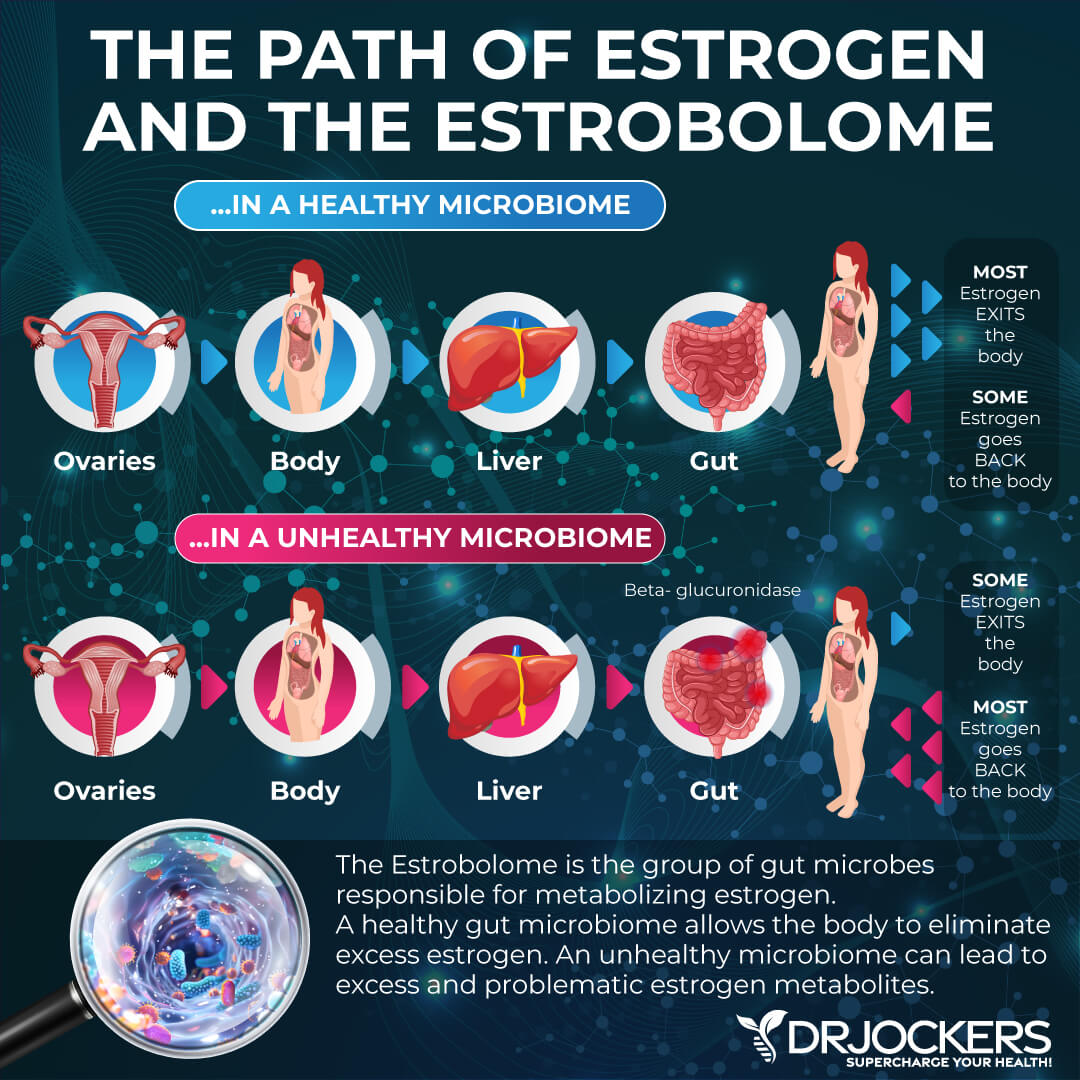
The Basics of Estrogen and Estrogen Metabolism
Estrogen is the main female sex hormone, but it is also present in men. It plays a role in reproduction in women and is important for sexual function in men. It has many other critical roles in the body, including the regulation of body fat, cardiovascular health, bone turnover, and cell replication.
Estrogens circulate in the blood in free or protein-bound forms and exert diverse biological effects (1). Estrogens bind to certain receptors found within the nucleus of our cells. There are two main types of estrogen receptors, estrogen alpha and estrogen beta.
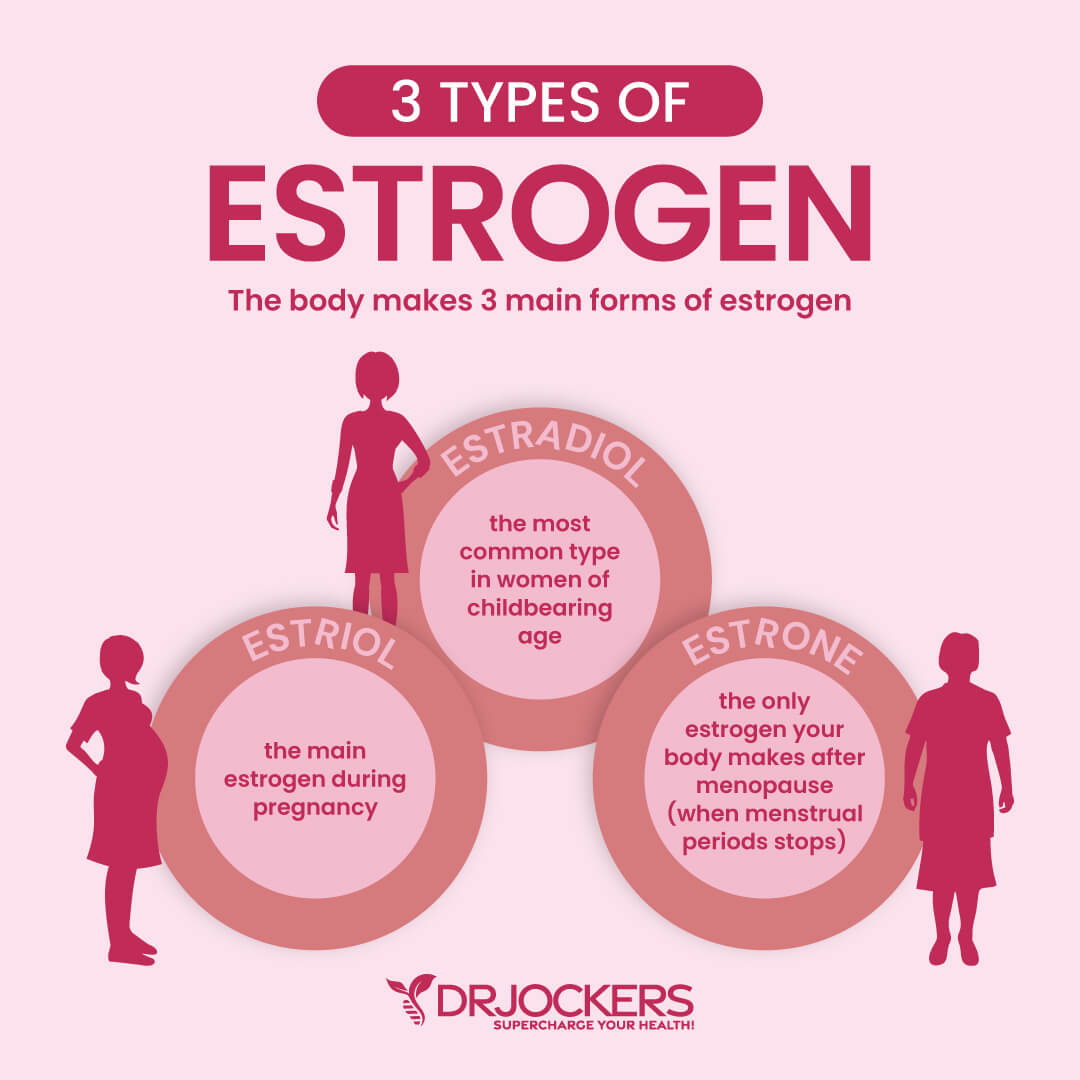
Forms of Estrogen
There are three main forms of endogenous estrogens:
- Estradiol (E2): considered the dominant estrogen; predominant in women prior to menopause
- Estrone (E1): predominant after menopause
- Estriol (E3): highest during pregnancy.
Estradiol can be converted to estrone and estrone in turn can convert into estradiol. Both estradiol and estrone can convert into estriol.
Production of Estrogen
Estrogens are primarily produced in the ovaries, adrenal glands, and adipose tissue. It is built from cholesterol.
For premenopausal women, most estrogens are produced in the ovaries. Ovarian production of estrogen greatly decreases after menopause, and most estrogen is produced through the aromatization of androgens (testosterone and androstenedione) in the fat cells. Testosterone is converted into estradiol, while androstenedione is converted into estrone.

Estrogen Metabolites
Estradiol and estrone both lead to the formation of estrogen metabolites. These include 2-hydroxyestrone (2-OH), 4-hydroxyestrone (4-OH), and 16á-hydroxyestrone (16á-OH). These metabolites have different biological activities. The 2-OH metabolite has weak estrogenic activity and is protective. The 4-OH and 16á-OH have a greater amount of estrogenic activity and can be harmful and carcinogenic.
Estrogens are eliminated from the body by metabolic conversion to inactive metabolites that are excreted in the urine or stool. If there are imbalances in your gut flora, these estrogens can be recirculated in the body rather than excreted. When they are recirculated back into the bloodstream, these estrogens are in a more toxic form than when they entered the liver.
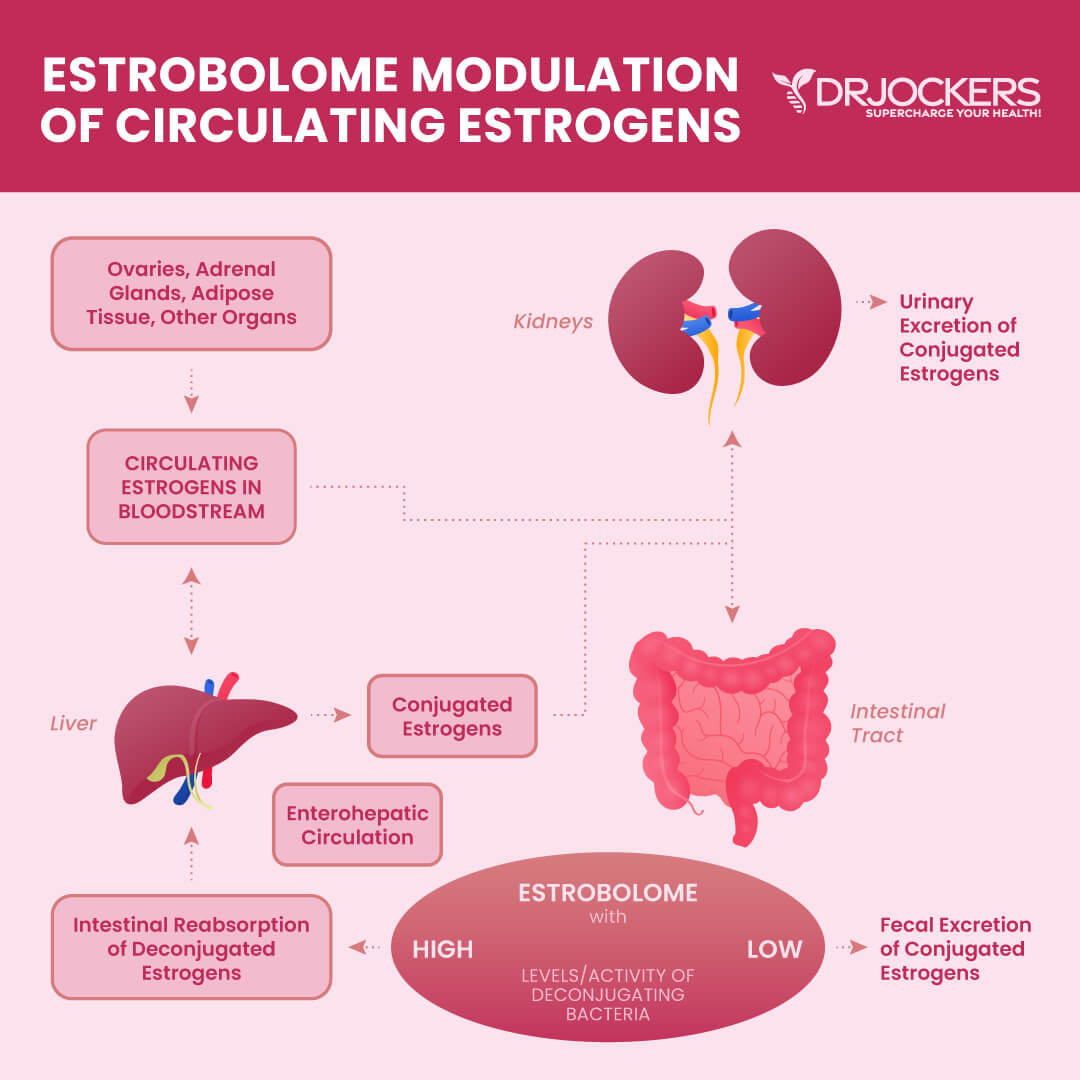
How Gut Flora Affects Estrogen Metabolism
The gut flora, or microbiome, is made up of trillions of microorganisms. It is important for the different types of bacteria that make up our gut flora to be in proper balance. When your gut microbiome is out of balance (dysbiosis) and gut microbiota diversity is reduced, this impacts your hormones and can lead to numerous health issues.
An important role of the gut flora is the modulation of systemic estrogens. The estrobolome is a certain gut bacteria that are responsible for metabolizing estrogen. The estrobolome modulates estrogen metabolism and affects whether estrogen is excreted from the body or recirculated. Normally, circulating estrogens are metabolized and conjugated in the liver via glucuronidation. Glucuronidation results in glucuronides, which do not bind to estrogen receptors.
Estrogens conjugated with glucuronic acid are more hydrophilic, which allows for them to be excreted. They are primarily excreted from the liver into the bile and then in the stool. A small amount is excreted in the urine. This normal liver detoxification process can be reversed when there are high levels of beta-glucuronidase.
Beta-glucuronidase is an enzyme produced by the estrobolome that deconjugates estrogens into their active forms (2). The active and unbound forms of estrogen enter the bloodstream and act on estrogen receptor sites. There are estrogen receptors throughout the body, including in the brain, bones, and gut. The production of beta-glucuronidase is altered by imbalanced gut flora. Imbalances in gut flora disrupt estrogen homeostasis and can lead to many health conditions.

Estrogen Metabolism and Altered Beta-Glucuronidase Activity
Beta-glucuronidase activity is reduced when gut microbiome diversity is reduced due to inflammation and gut dysbiosis. This results in decreased deconjugation of estrogen and phytoestrogens into their circulating and active forms.
Low Estrogen
A decrease in circulating estrogens alters estrogen receptor activations. Low circulating estrogen levels can lead to obesity, metabolic syndrome, cardiovascular disease, osteoporosis, and cognitive decline (3). Women with polycystic ovary syndrome (PCOS) have an altered gut flora, which may contribute to excess androgen production.
Excess Estrogen
The more beta-glucuronidase that is produced, the more estrogen is recirculated rather than excreted. Reabsorption of free estrogens can lead to estrogen dominance and increase the risk of estrogen-driven cancers such as breast, ovarian, and endometrial cancers. Estrogen dominance also contributes to conditions such as endometriosis.
It is important to improve and balance your gut flora for healthy estrogen metabolism. Let’s look at how you can do that.

Ways to Improve Estrogen Metabolism
There are strategies to improve your estrobolome. An anti-inflammatory diet and avoiding toxins are key, along with supporting your liver and daily bowel movements. Antibiotics and birth control pills can alter the gut microbiota and estrogen levels and should only be taken when necessary.
Supplementing with probiotics and hormone-balancing herbs and nutrients can also be very helpful for improving gut flora and metabolizing estrogen. For more tips on how to balance estrogen naturally, check out this article.

1. Anti-Inflammatory Healing Diet
Diet has a profound impact on your gut flora. An anti-inflammatory, healing diet removes foods that cause inflammation and disrupt the microbiota and includes organic, non-GMO vegetables, fruits, healthy fats, and clean protein.
A healing diet reduces inflammation, stabilizes blood sugar, reduces toxic load, provides necessary nutrients, and supports healthy blood pH levels. The first 3 steps on a healing diet include getting rid of sugar and grains, switching to healthy fat sources, and organic and pasture-raised animal products.

Food to Avoid
For a healthy gut microbiome, it is critical to avoid highly inflammatory foods. Highly inflammatory foods are refined sugars and grains, and any foods that are easily metabolized into sugar (high glycemic foods). Refined carbohydrates upregulate inflammation, create extra acidity in the tissues, and create imbalances in your gut flora and hormones.
Meat and dairy from conventionally-raised animals, farmed fish, non-organic fruits and vegetables, and highly processed vegetable oils, such as canola, grapeseed, and safflower, promote inflammation and should be eliminated. The toxins in these foods can worsen gut health and destroy good bacteria. These foods also contain endocrine disruptors such as hormones, steroids, pesticides, GMOs, and antibiotics.

Foods to Include
The foods you should be eating on an anti-inflammatory, gut-healing diet are whole, unprocessed foods. Choose grass-fed, pasture-raised, wild-caught meats and fish. Enjoy a variety of lower-carbohydrate, low-glycemic, colorful vegetables and fruits for their abundant antioxidants and phytonutrients. Plentiful amounts of herbs are also wonderful to use on a healing diet.
Cruciferous vegetables are excellent for supporting proper estrogen metabolism. They are rich sources of sulfur-containing glucosinolates, which help to detoxify bad estrogen molecules (4). The glucosinolates give cruciferous vegetables their pungent aroma and spicy taste.
When cruciferous vegetables are cut, chopped, or chewed, an enzyme is released that activates sulforaphane. Sulforaphane is an isothiocyanate that has been found to have cancer-protective properties and other health benefits (5). Broccoli sprouts, kale, cauliflower, collard greens, mustard greens, turnips, broccoli, Brussels sprouts, watercress, and cabbage all contain sulforaphane.
Fruits and vegetables contain fiber, which helps good bacteria in the gut to thrive. The best low glycemic fruits for balanced gut flora are berries, lemons and limes, grapefruit, and Granny Smith apples.
Healthy fats are essential for hormone production. Great sources of healthy fats are coconuts, olives, avocados, their oils and grass-fed butter and ghee. Omega-3 fatty acids and conjugated linoleic acid (CLA) found in wild caught salmon and grass-fed beef and dairy have many health benefits. These healthy fats are an efficient source of fuel for the body to combat inflammation and support and healthy gut.
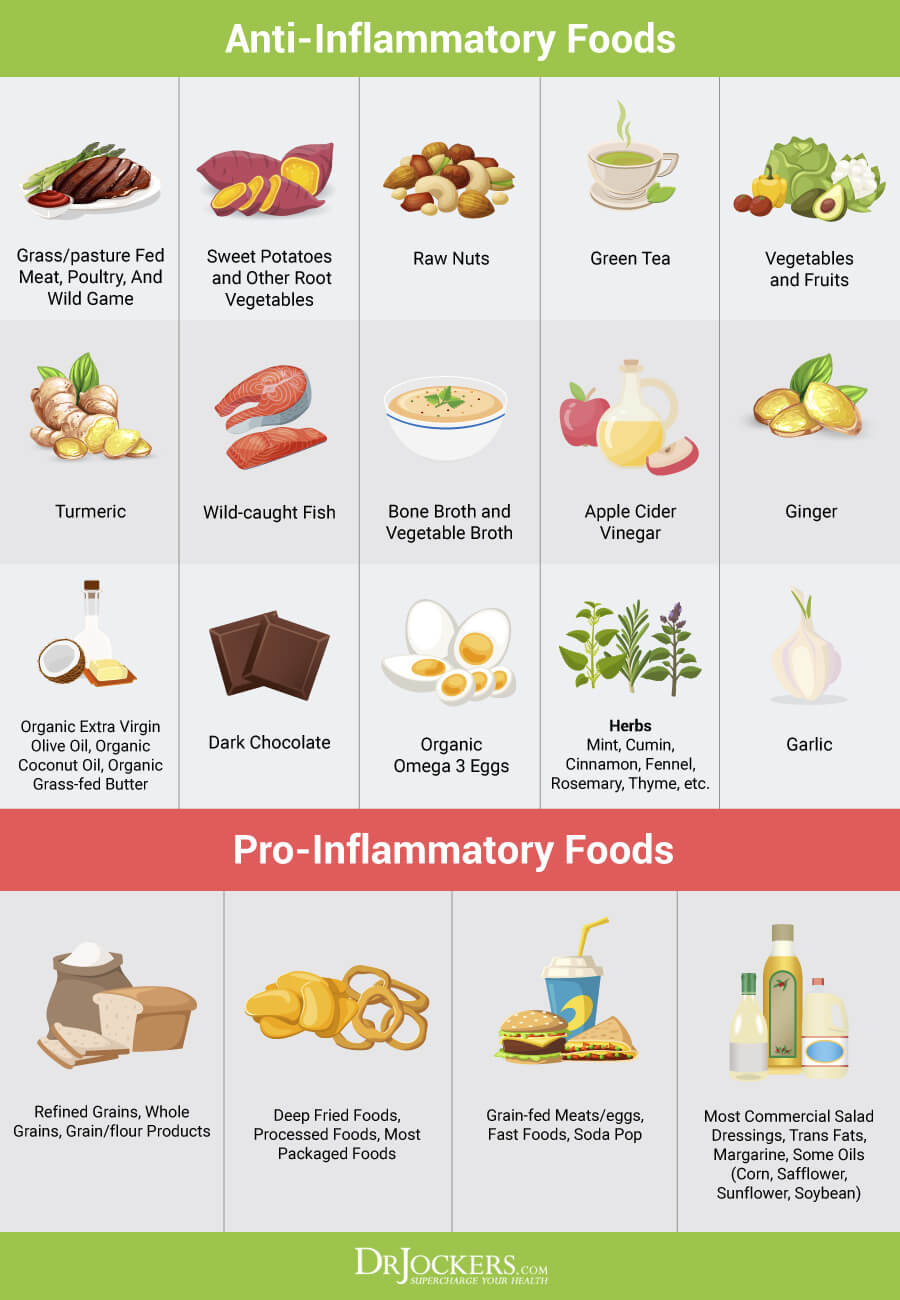
2. Avoid Xenoestrogens
Endocrine disruptors are toxins that can interfere with the body’s hormone system (6). These hormonally active compounds mimic naturally occurring hormones in the body.
Xenoestrogens mimic estrogen and interact with cellular receptor sites. This contributes to excess estrogen and blocks the effects of true estrogen. Xenoestrogen exposure can lead to many serious health conditions including cancer (7).
Unfortunately, xenoestrogens are found in many every day products. Examples are plastic bottles, food cans, detergents, flame retardants, cosmetics, and pesticides may contain these endocrine disrupting substances.
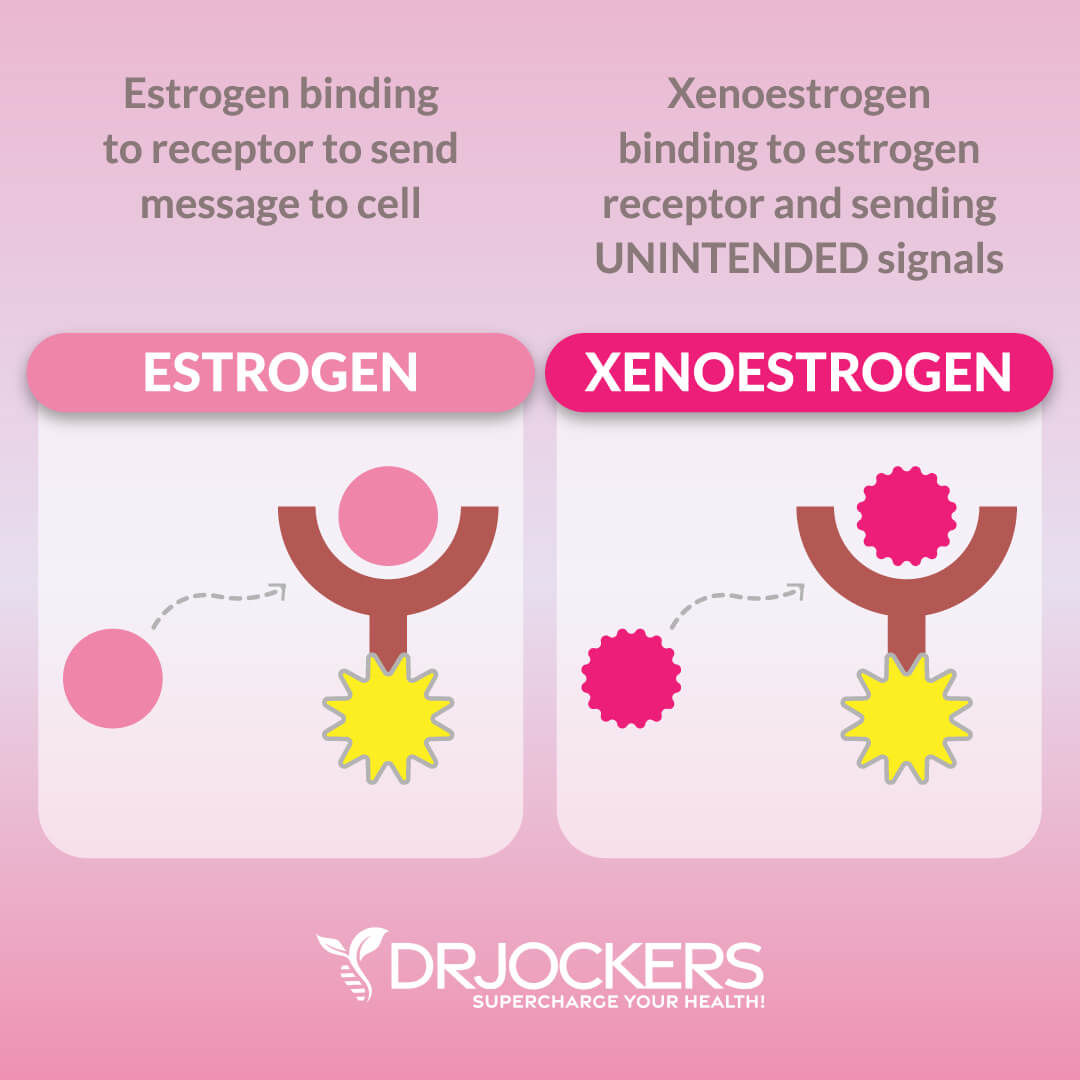
3. Limit Antibiotics and Birth Control Pills
The use of birth control pills and the overuse of antibiotics can cause imbalances in your estrobolome. Antibiotics kill good bacteria in addition to the bad bacteria.
Birth control pills can eliminate the good bacteria in your gut and encourage dysbiosis and overgrowth of bad bacteria. They can also lead to small intestinal bacterial overgrowth (SIBO), which can make hormonal symptoms worse.
4. Support the Liver
Detoxifying your liver can help to naturally balance hormones. As discussed above, the liver is responsible for breaking down and eliminating excess hormones from the body. If the liver is not functioning properly, older hormones can recirculate into the bloodstream in an even more toxic form than when they originally entered the liver.
Kidney & Liver Detox is a bioactive carbon product that focuses on drainage and immune support throughout the kidneys and liver. It contains milk thistle, along with NAC, parsley, gynostemma, collinsonia root, beet root, and marshmallow root. Milk thistle protects the liver from damage, enhances the detoxification process, and speeds up estrogen clearance from the body.
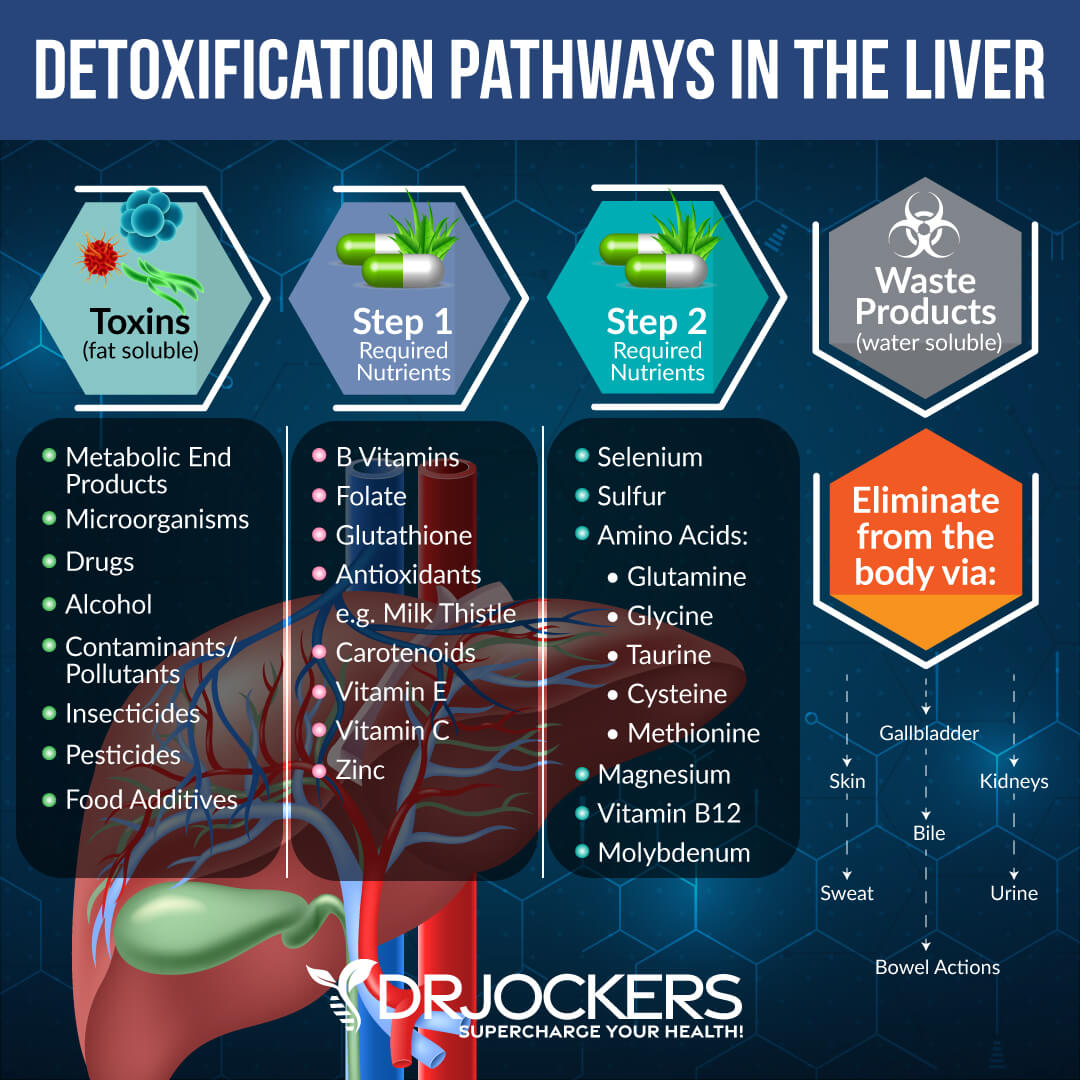
5. Add Probiotics
Probiotics can help to restore a healthy estrogen balance by helping to improve the estrobolome (8). ProbioCharge is an ideal combination of ingredients to support your gut flora, cellular health, and immunity. It contains well-researched probiotic strains, Saccharomyces boulardii, and the prebiotic arabinogalactan.
Another option is the soil-based probiotic SBO Probiotics – Ultimate. This probiotic contains a powerful array of soil-based organisms and prebiotic superfoods to reduce the overgrowth of pathogenic microorganisms and to repopulate the gut effectively with healthy microbes.
6. Support Good Elimination
Daily bowel movements are very important for a healthy gut flora. When you are not eliminating daily, waste sits or moves slowly through your digestive tract. This waste is fermented by bacteria and becomes a breeding ground for bad microbes. An overgrowth of bad bacteria leads to hormonal imbalances. These microbes also release toxins that create inflammation throughout the body.
A fantastic supplement for natural, gentle relief from constipation is Oxy Powder. This product is specifically designed to promote digestive and detoxification support without causing cramping or dependency.
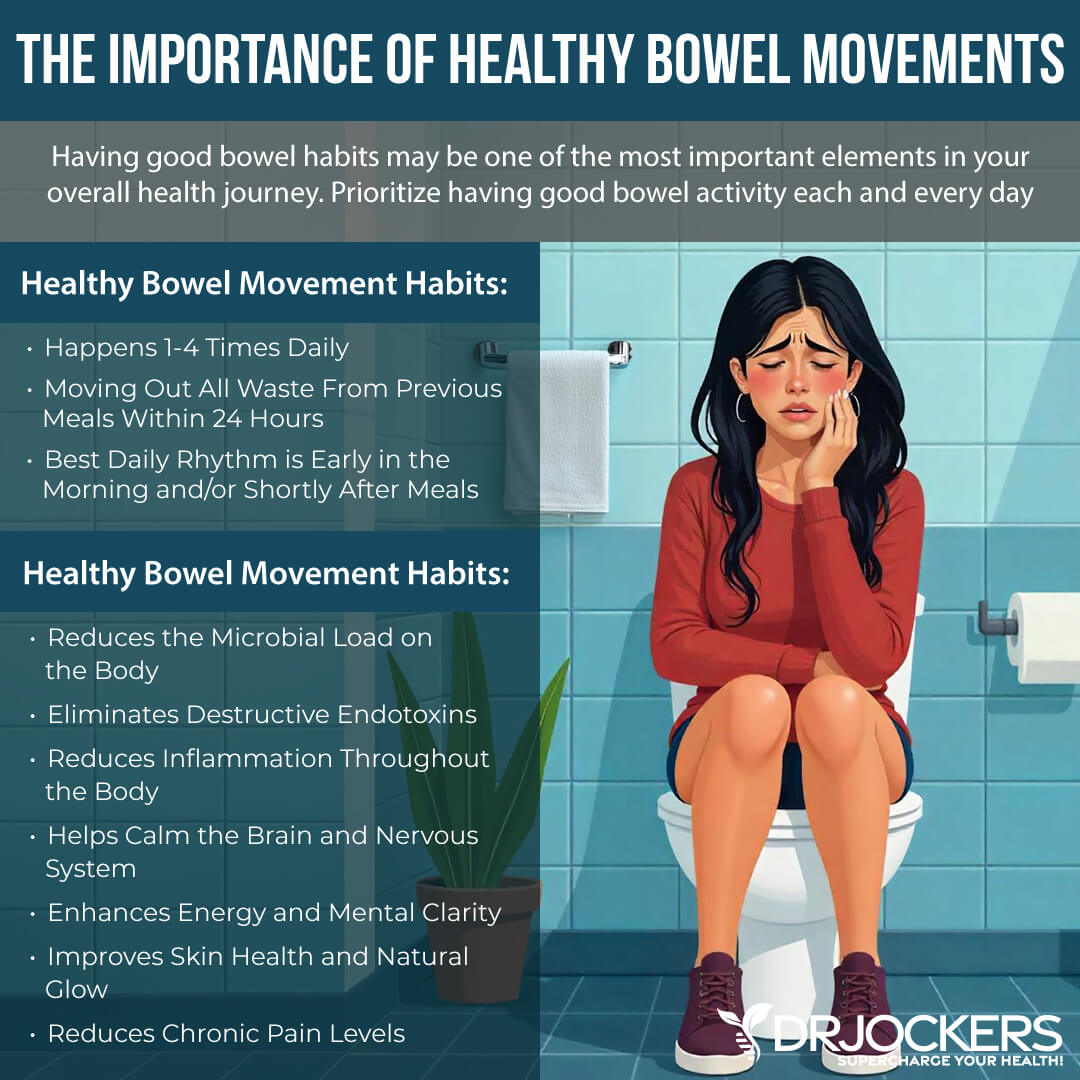
Supplemental Support for Hormonal Balance and Estrogen Metabolism
There are many nutrients and herbs that can help balance hormones. Fem Protect is a fabulous supplement that contains classic herbs such as vitex, polygonum, and black cohosh. It contains diindolylmethane (DIM) and chrysin for protection and support of beneficial estrogen aromatase activity, and calcium D-glucarate, which promotes the proper elimination of excess estrogens.
Vitamins B6, B12, and folate are included in Fem Protect to support proper cell differentiation. These nutrients also support the methylation pathway that helps to clear estrogens from the body in phase II of liver detoxification. Fem Protect also contains the antioxidants resveratrol and EGCG from green tea, along with calcium and magnesium to support bone and hormone health.
Vitex
Vitex, also called Chaste Tree or Chaste berry, is known as nature’s hormone balancer. It contains flavonoids, iridoid glycosides, and terpenoids. Vitex is known for relieving premenstrual syndrome (PMS) and menopausal symptoms, including breast pain, cramps, and hot flashes.
DIM
Diindolylmethane (DIM) promotes healthy estrogen metabolism and creates a better balance of estrogen metabolites (2-OH, 4-OH, and 16 alpha-OH). This happens through phase I cytochrome P450 enzyme induction and promotion of 2-hydroxylation.
DIM helps to restore healthy hormone balance by adjusting the balance of estrogens and blocking aromatase, which converts testosterone to estrogen.
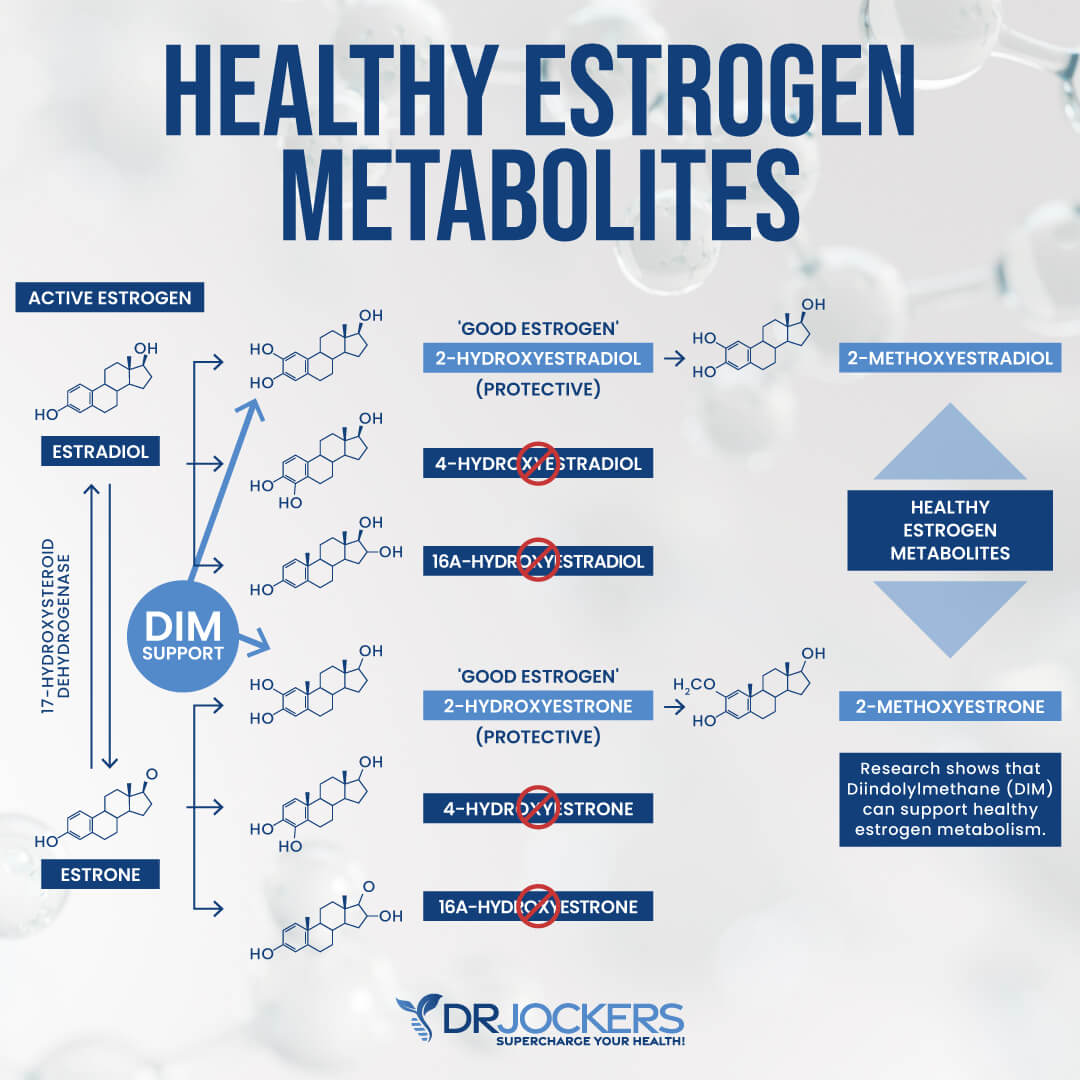
Calcium D-Glucarate
Calcium D-Glucarate (CGT) is converted metabolically to an inhibitor of beta-glucuronidase in the intestine. CGT forms D-glucaric acid, from which the potent beta-glucuronidase inhibitor D-glucaro-1,4-lactone is derived.
This can help to prevent deconjugation and reabsorption of estrogen and toxins while increasing their elimination. I find that many people need this unique and mostly unheard-of compound.
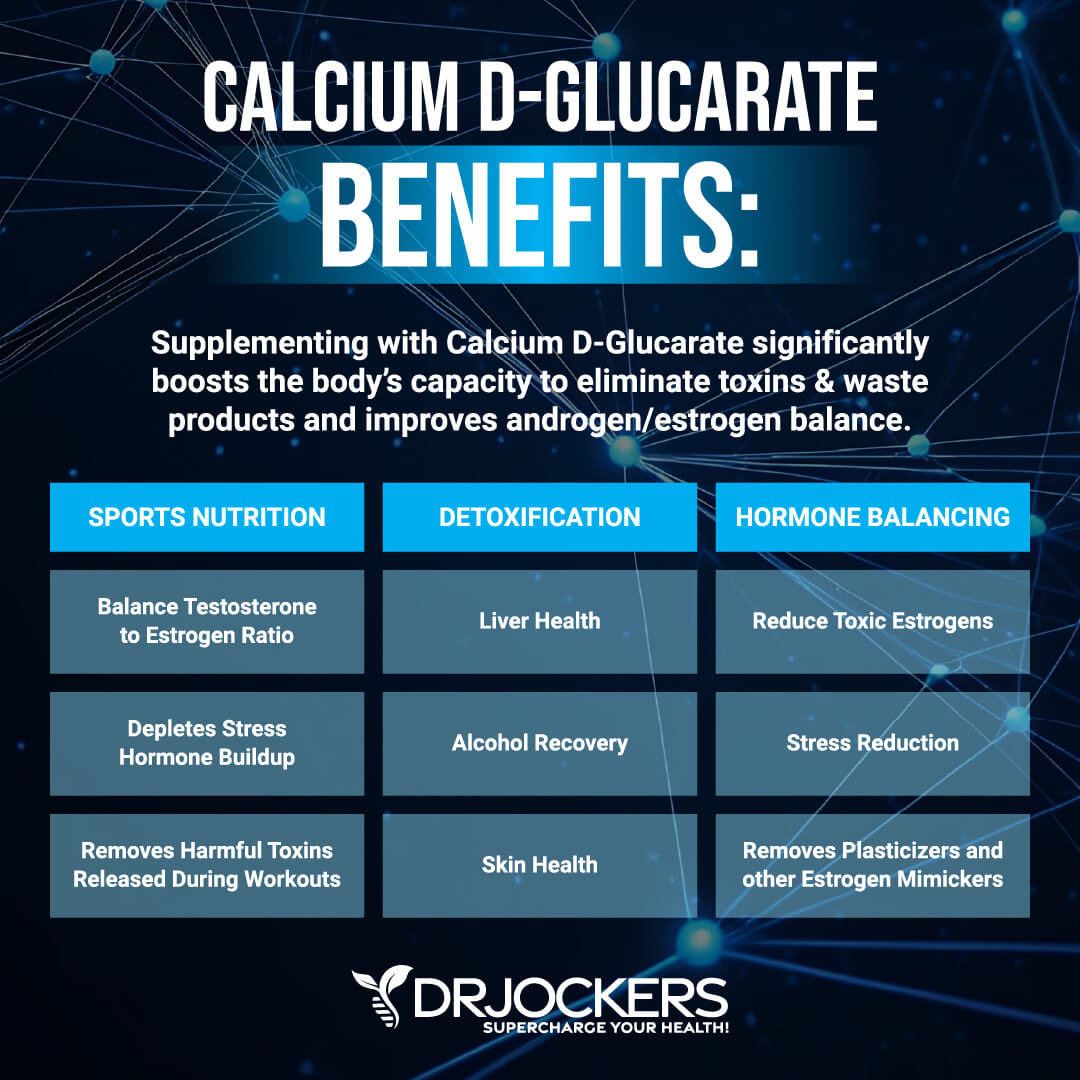
EGCG
Epigallocathechin-3-gallate (EGCG) is a bioactive botanical in green tea polyphenols. EGCG is the most abundant catechin in green tea and accounts for more than half of the total polyphenol and effective content in green tea. Studies have shown that EGCG has cancer protective benefits through several mechanisms (5).
Magnesium
Magnesium is involved in the production of estrogen, progesterone, and testosterone in the body. It is also critical to phase II liver detoxification. It is a cofactor for the enzyme that removes toxic forms of estrogen from the body.
Estrogen alters magnesium levels by enhancing magnesium utilization and uptake by soft tissues and bones. When estrogen is high and magnesium intake is not optimal, this can lead to heart disease, osteoporosis, and other conditions (9).
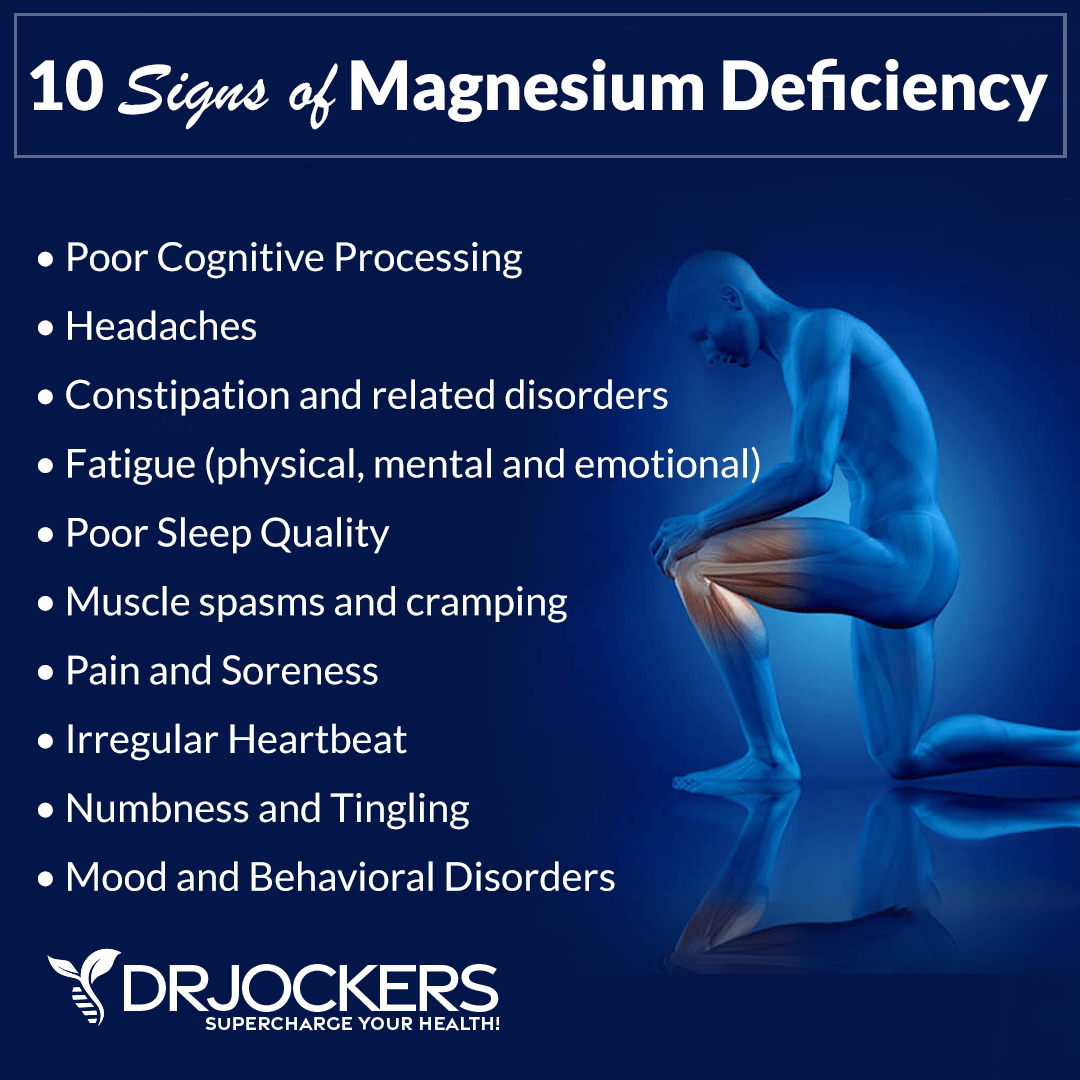
Helpful Lab Testing for Estrogen Metabolism and Gut Health
There are testing options to look at how you metabolize estrogens, your hormone levels, the balance of bacteria in your gut flora, and the health of your gut. The insight these tests reveal can be extremely valuable.
1. The DUTCH Test™
The best way to test for estrogen metabolism and overall hormonal health is the Dutch Complete Hormone Panel. DUTCH is an acronym for Dried Urine Test Comprehensive Hormones. As the name implies, the DUTCH test is a urine test that can be performed at home. You simply collect a small amount of urine on filtered paper four times a day.
This comprehensive hormone test measures:
- Cortisol
- Cortisone
- Cortisol and cortisone rhythms and levels
- Estradiol
- Estrone
- Estriol
- Estrogen metabolism pathways
- Progesterone
- Testosterone
- DHEA
- Etiocholanolone and androsterone
- Melatonin
- 8-OHdG – a marker of oxidative stress
- Neurotransmitter metabolites
- B vitamins
This test measures androgen production, how you metabolize estrogen, cortisol, and many cortisol metabolites. This test gives a complete picture of your hormonal health.
2. GI-MAP™ DNA Stool Analysis
The GI-MAP Stool Analysis Test is the most thorough stool test on the market. It is a comprehensive stool analysis that identifies your levels of normal (good) bacteria as well as dysbiotic (bad) bacteria in the gut. It is a fantastic way to measure imbalances of your gut flora.
In addition to bacteria, the GI-MAP can detect Candida and other fungi, and parasites, including both protozoa and worms. This comprehensive stool test can reveal if you have H. pylori, viral pathogens, potential autoimmune triggers, and viruses, including cytomegalovirus and Epstein-Barr virus.
The GI-MAP is the only FDA-approved DNA test for gastrointestinal microbes and pathogens available. The GI-MAP also tests for The GI Map reveals the health of your intestines with digestion, gastrointestinal, Secretory and Anti-gliadin IgA (immune response), and calprotectin (inflammation) markers.
Another great thing about the GI-MAP is that the test gives actionable biomarkers. The GI-MAP looks at all the major factors that can influence the health of the gut and what compounds will work best to eliminate the various pathogens. For more information on the GI-MAP and a sample report, you can look here.
Final Thoughts on Estrogen Metabolism
Your gut flora has many critical functions in the body, including regulating estrogen levels. The estrobolome is the collection of microbes in the gut that are responsible for metabolizing estrogens.
The estrobolome produces beta-glucuronidase, an enzyme that deconjugates estrogens into their active forms to carry out many physiological processes. Altered beta-glucuronidase activity can be a major factor in a woman’s exposure to circulating estrogens.
Lower estrogen levels can lead to chronic diseases such as obesity, cardiovascular disease, PCOS, and osteoporosis. High levels of circulating estrogens create estrogen dominance, which causes many unwanted symptoms and is linked to endometriosis, certain cancers, and other conditions.
It is critical to address any imbalances in your gut flora to prevent or improve imbalances in your hormone levels. Improving your diet, reducing exposure to xenoestrogens, supporting the liver and good elimination, supplementing with probiotics, and hormone-balancing herbs and nutrients are effective strategies for improving gut flora and estrogen metabolism.
To test how your body metabolizes estrogen and your hormone levels, the DUTCH Test (Dried Urine Test for Comprehensive Hormones) is an easy, at-home urine test. If you would like an overall picture of your gut microbiome, the GI Map shows your levels of normal and dysbiotic bacteria. If you are experiencing problems with estrogen balance, than I recommend supplementing with Fem Protect which supplies a full range of nutrients for healthy estrogen metabolism.
If you want to work with a functional health coach, I recommend this article with tips on how to find a great coach. Our website also offers long-distance functional health coaching programs with our world class team of health coaches. For further support with your health goals, just reach out and our fantastic coaches are here to support your journey.
Inflammation Crushing Ebundle
The Inflammation Crushing Ebundle is designed to help you improve your brain, liver, immune system and discover the healing strategies, foods and recipes to burn fat, reduce inflammation and thrive in life!
As a doctor of natural medicine, I have spent the past 20 years studying the best healing strategies and worked with hundreds of coaching clients, helping them overcome chronic health conditions and optimize their overall health.
In our Inflammation Crushing Ebundle, I have put together my very best strategies to reduce inflammation and optimize your healing potential. Take a look at what you will get inside these valuable guides below!
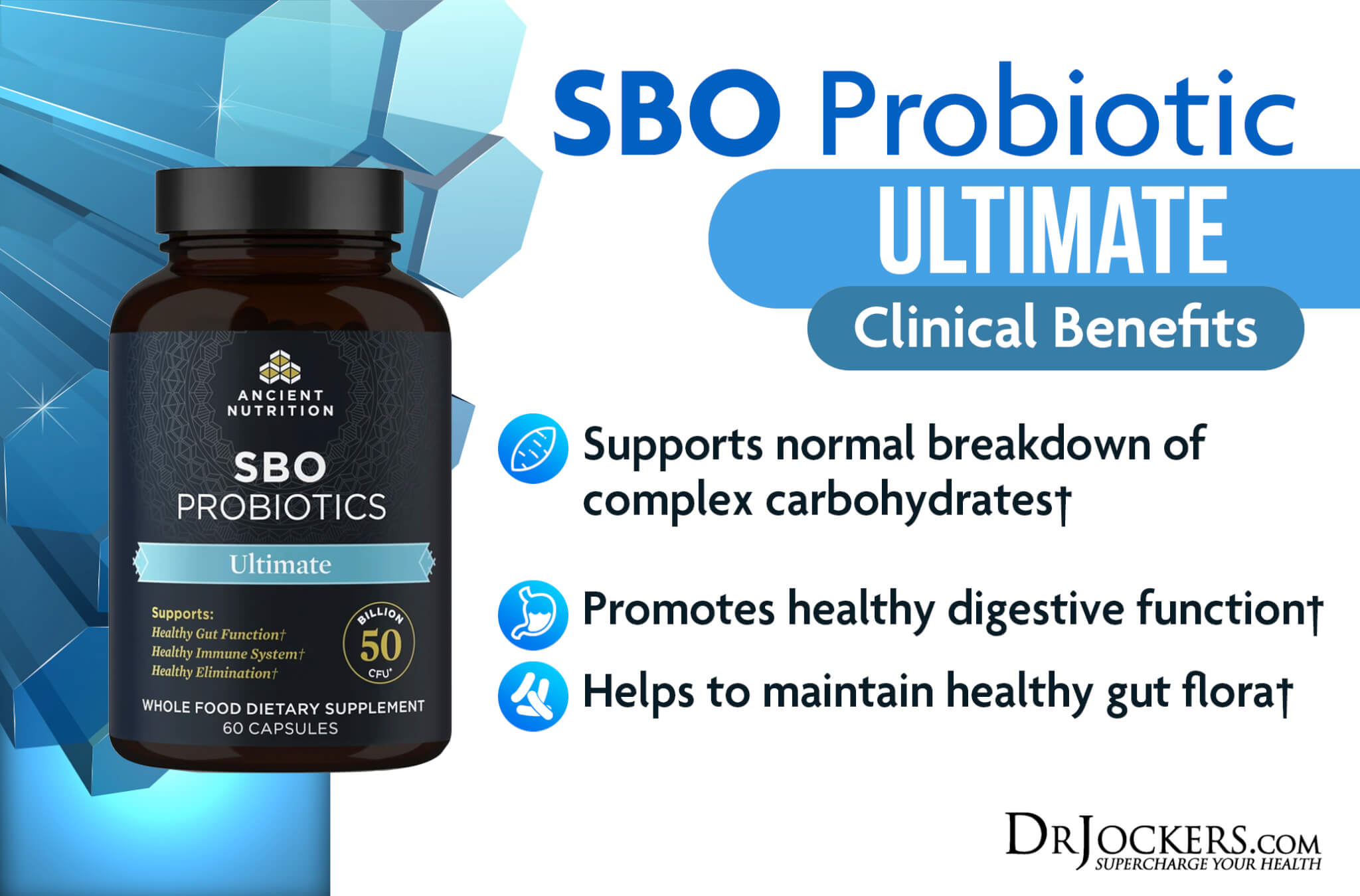
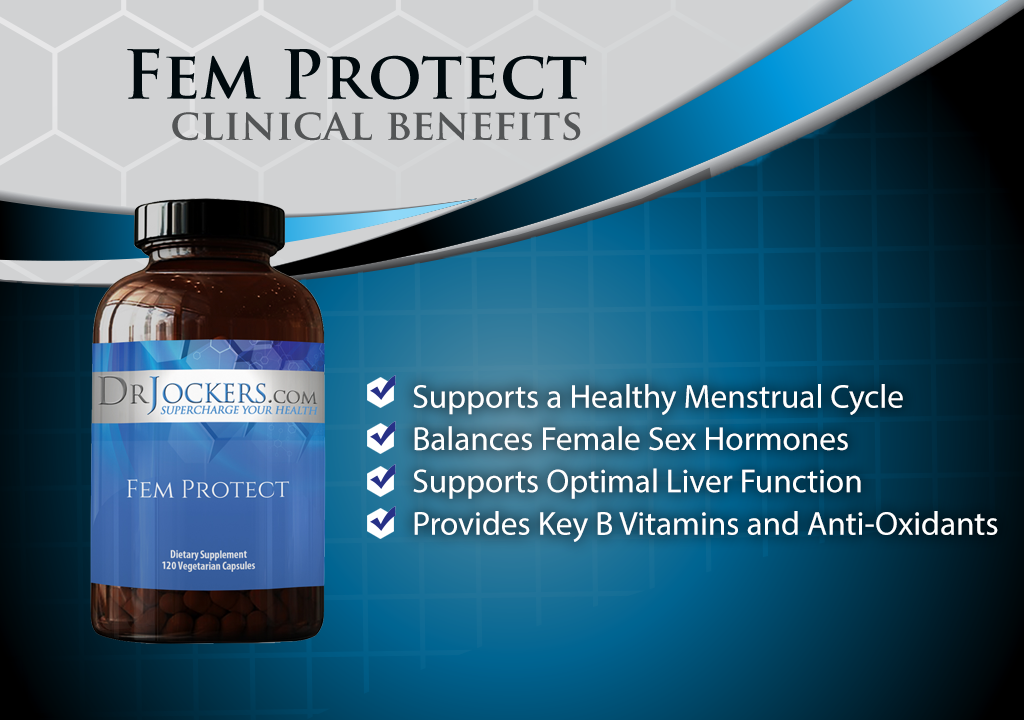






Genova tests for hormones/allergies/vitamins is good. A person still needs to adjust hormones if they take bioidentical hormones themselves to get the right dose. Cu may raise estrogen and Zn may raise Testosterone. Estriol/progesterone/testosterone after menopause in the right ratios may help some people, but may shut down their own glands/production. B vitamins may help detox estrogen and probiotics like Orthobiotic are awesome help which multiply B vitamins. Testosterone is one H atom different than estrogen. Testosterone counteracts the swelling of estrogen. Progesterone makes estrogen receptor sites more sensitive/helps PTSD/hot flashes/swelling/water weight/thyroid/myelin/bones and more. Vit B12 methylcobalamin may help the myelin/bones/oxygen/stress/fear etc. Stress lowers Zn/B vitamins and progesterone. A daily walk in the sun may help stress/get Vit D/make a person happier and stop autoimmune attacks. Vit D3 5000IU/Vit K2 and more may help. Grounding or Astaxanthin may help free radicals/normalize health issues/help swelling/inflammation. No gluten/GMO may help intestines heal and absorb more nutrients the brain/body need to work right and stop attacks on glands etc.
Hi Shasha, Yes, a lot of great advice! Thanks for sharing.
I hae had estrogen receptor+ breast cancer, and a year prior to my diagnosis I tested slightly higher than the upper limit for beta glucuronidase. I have since had a lumpectomy and radiation and am now on a hormone blocker, which is causing me issues, and I worry about side effects such as osteoporosis. I’m on a hormone blocker to lower estrogen now. I’m not sure if I should also be following a natural diet to further eliminate/balance estrogen while on the blocker. I’m sure my oncologist would just advise me to “eat healthy,” but I want to do all I can naturally to prevent a recurrence. Would you recommend the supplements suggested in my case, or calcium d-glucarate or would they only be recommended if I’m no longer on the estrogen hormone blocker? Thank you for all your good work.
Sorry to hear this! I would recommend getting a work up with a functional health coach who can help personalize a plan for you! https://drjockers.com/functional-nutrition-tips-to-find-a-great-health-coach/
Hi Dr J,
What Detox supplements would you suggest for a 9 year old? My daughter unfortunately got exposed to a lot of plastic and estrogenic products while she was younger, and I think she can benefit from a Detox protocol. I started her on the BioToxin Binder but not sure if that’s best for her.
Regards,
Savera
Hello Savera,
Yes for children, we usually use the Bioactive Carbon Minerals – 4 drops – 3x daily and the ZeoTrex: 10 drops – 2x daily. Use coupon code Jockers10 at checkout to save 10%
Zeotrex: https://store.drjockers.com/products/zeotrex
Bioactive Carbon Minerals: https://store.drjockers.com/products/bioactive-carbon-minerals
Thanks Dr J,
Just ordered these. Can these be given together mixed in water, or separately?
Regards,
Savera
Yes they can be given together.
Hi Dr J,
I gave this combo to my daughter on your suggestion. But I saw the NDF Pooper which is detox for kids, especially for BPA. Would that be a better option for a 9yo who has been exposed to a lot of plastics/BPA when younger, and has a sluggish thyroid? Posting here as I didn’t see an option for Q&A on the NDF Pooper.
Regards,
Savera
Yes the NDF Pooper can be very helpful here and also the NDF Calm: https://store.drjockers.com/products/ndf-calm